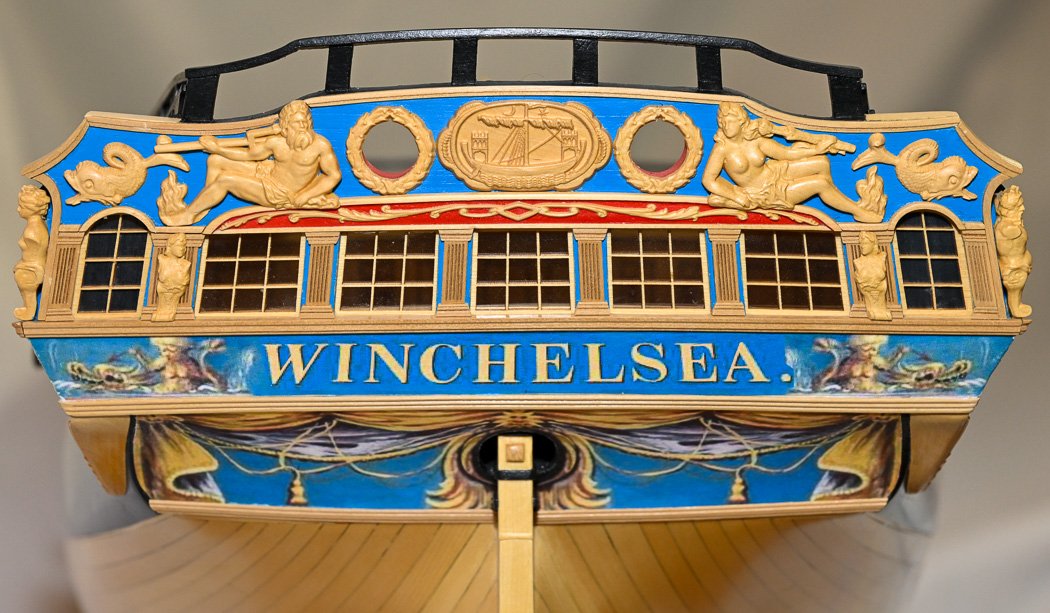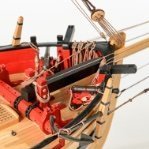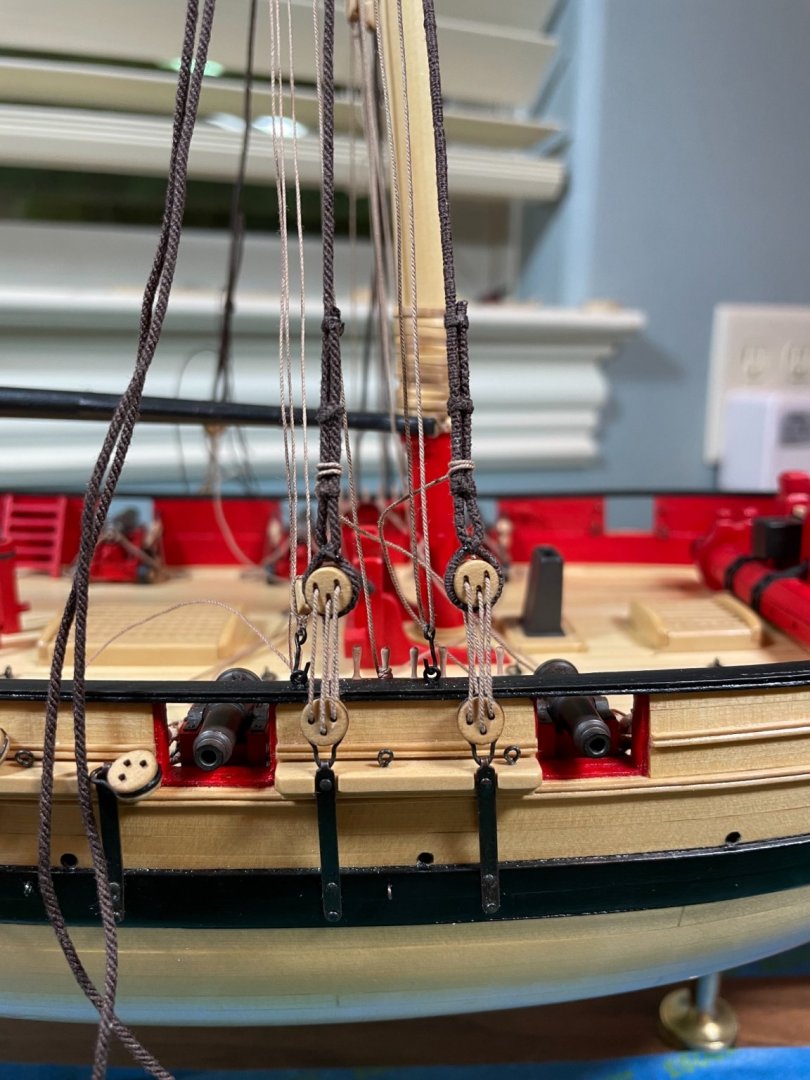-
Posts
4,111 -
Joined
-
Last visited
Content Type
Profiles
Forums
Gallery
Events
Everything posted by glbarlow
-
More great work BE. Could you provide the source for your micro chisels? They look like nice tools to have.
- 185 replies
-
- queen anne barge
- Syren Ship Model Company
-
(and 1 more)
Tagged with:
-
Impressive carving. Definitely not something I have the patience for doing. Congratulations on finishing these!
- 185 replies
-
- queen anne barge
- Syren Ship Model Company
-
(and 1 more)
Tagged with:
-
I may yet. I’d go for the Cherry version.
- 642 replies
-
- winchelsea
- Syren Ship Model Company
-
(and 1 more)
Tagged with:
-
I get more and more tempted when I see yours and others on this beautiful but huge ship.
- 642 replies
-
- winchelsea
- Syren Ship Model Company
-
(and 1 more)
Tagged with:
-
Thank you BE, your comments are very much appreciated. As often as I’ve removed or replaced things I feel like I’ve built her twice and there are times, like now, when I’ve slowed to a crawl on progress. What speed I’ve gained comes in large part to having great logs like your Cheerful build as a ready reference and example.
- 778 replies
-
- cheerful
- Syren Ship Model Company
-
(and 1 more)
Tagged with:
-
Thank you for the comment, much appreciated.
- 778 replies
-
- cheerful
- Syren Ship Model Company
-
(and 1 more)
Tagged with:
-
Fortunately I don’t. People buy my work, but I don’t live by it. Very few do, and they exist on tours, not selling prints.
-
Maybe…
-
I could tell you how to to fix that, it’s pretty simple to get it whiter, in camera and or in Lightroom. However I agree with you, the soft background highlights the model. As a photographer I know that more isn’t always better. The model suspended in a ultra white universe with no balance or grounding (like shadows at the base) just looks weird and unsettling. Still one thing to try is using a light to just light the background either from above or the sides. That will give you more contrast and separate the model without sending it off into a white void. James knows how to do this very well with his product photography. I can do it, but it’s not my specialty. Focus stacking is easy in my D850 and Z7, a little harder in older cameras and not insignificant post work regardless of camera. You can get the ship in focus between f/11- f/16. (Well, Winnie is really big:-) without all that hassle. I’d recommend your photography energy be spent on lighting and basic processing. Just my two cents.
-
It’s quite famous and a long held mystery. How do they get out on the dry lake bed and how do they move…know one know for sure, aliens is one theory. 🤣
-
Indeed it has been. Maybe I’m going slower now because I’m not that anxious to finish her… Thank you, it’s been a good year…….for model building……
- 778 replies
-
- cheerful
- Syren Ship Model Company
-
(and 1 more)
Tagged with:
-
She’s had quite a few new modeling tools, but I’m sure there is at least one more, can’t have too many.
- 778 replies
-
- cheerful
- Syren Ship Model Company
-
(and 1 more)
Tagged with:
-
Not by much if you’re on your masts. It’s a fun build. 👍🏻
- 778 replies
-
- cheerful
- Syren Ship Model Company
-
(and 1 more)
Tagged with:
-
Good catch, thank you. Silly error, this is why I don’t tie off permanently to quickly.
- 778 replies
-
- cheerful
- Syren Ship Model Company
-
(and 1 more)
Tagged with:
-
Today marks my 1 year anniversary working on Cheerful. This is often the chance to show progress photos, however I’m buried sorting out shrouds. So much fun……yes I noticed I’d managed to snag the peak halyard tackle in the lanyard 🤣 Two down six to go. Lanyards are temporary until all four per side are complete.
- 778 replies
-
- cheerful
- Syren Ship Model Company
-
(and 1 more)
Tagged with:
-
Do you have a build log, I’d enjoy seeing another Cheerful underway?
-
As described in my. Cheerful log, I used black masking tape on the mast, boom, and, gaff then painted over the tape. A little CA and the Paints seals it all with a tight fit. It works great. The “tab” was formed by shaping a strip of brass the same width as the tape I cut including down to a pin to insert through the tape. The tab has to be solid and thick enough to hold the weight of the throat halyard You can see the result in my build log.
-
Since you have Photoshop play with tweaking white balance. This works much better if the photos are shot RAW, but jpegs can also have WB adjusted to a degree. Maybe reduce magenta or just slide the temperature left (cooler) a bit. Though not on a model photo, I’ve spent hours on editing a single landscape photo, many of which are in my galleries at GlennBarlow|Photography Yes blatant self promotion 😁
-
Not true on more advanced and newer iPhones. I can direct the focus point as I wish with my iPhone 12 Pro, I could as well with my prior iPhone X too.
-
While that’s true, f/22 is overkill. I rarely shoot more than f/13, even with the best lens you can get some barrel distortion around f/22. Now try changing your white balance to see what you like best. Sometimes Daylight is better than Flash when using a flash, cloudy is too much warmth and Auto is inconsistent in its guessing. LED lights are great but can toy with color balance. The shadows in part are because your subject is too close to the backdrop. Your right about shadows and drama, my Fair American gallery shots are done that way, Over lighting is as bad as under lightning. Contrast is good and shadows done well add depth. Nonetheless your photos from the last time have improved exponentially!! Well done! You’ll be headed for Iceland on a photo trip by summer 😃
- 725 replies
-
- vanguard models
- speedy
-
(and 1 more)
Tagged with:
-
We all get to experience our build and make decisions that suit us as the builder and represents what we choose to do. One clear thing about ship models is that there is not one clear thing. There are many ways to do the same thing, it may not suit how others would do it but that’s their problem not yours. This is your first build, the LN is well suited for that. For example, Walnut color variations are a common thing and blend together in the end or at worst add character. But this kit does have limitations, it’s not a high end kit Enjoy and learn. Don’t stress about master level techniques or trying to match the work of others. Build the model and learn the basics for the next more advanced model and finish with the love to do another model. I built this kit in light work in less than 3 months to decide if I enjoyed modeling again after a 3 year absence. I did and now have 12 months into Cheerful. Have fun, learn things. But recognize this kit isn’t going to earn its way into a museum but you hopefully will have enjoyed your process.
- 139 replies
-
- Lady Nelson
- Amati
-
(and 2 more)
Tagged with:
-
Actually bright can be achieved at most any aperture with adjustments to shutter speed and/or ISO. Most of my model shots are done between F/6.5 - f/11. Of course as with all photography the quality of light source is critical.
-
My first camera was a D90. It will do just fine. Put in Aperture Mode to be able to set what I suggested. My cameras are in that mode about 80% of the time, manual the rest. Auto (point and click) while fine for many things, isn’t great for our models. We need more control to focus on our strings. Also try using Single Point Focus. It means using the cursor to move a box around inside your viewfinder to lock the focus on what you want it to be instead of the camera deciding, which is often wrong, in AutoFocus mode. SP can be tricky, but it’s pretty much all I used on the D90. Experiment a bit and you’ll be expert in no time. James I think has more and better lights specific to product photography. With what you have you can get pretty close. Light Light Light is the key, I move around my work light even when using my iPhone.
- 725 replies
-
- vanguard models
- speedy
-
(and 1 more)
Tagged with:
-
That's great, I'm sure it will help. A few suggestions (which I'd gladly have given rather than kid you about it:-): Set the backdrop so that the bottom has a gentle curve as transition from bottom to back, no clear line transition makes it appear the ship is floating (see my more formal Cheerful photos of the hull, not the regular ones). Put the ship forward of the back paper by at least a couple of feet to prevent silhouettes of what you're photographing. Further, set the lights so they are not direct on the subject, with two lights put them at 45 degree angles. I usually have another light between the subject and the paper just lighting the paper, the brighter the whiter - if it isn't lit it will appear gray, which can be fine depending on what you want. My iPhone 12 pro is good enough I use it for most photos, but for the more formal stuff (and different than other advice I read) I set my Nikon D850 at Flash White Balance (or Daylight), F/11, ISO 400 (or even 800 but more than that is pushing it) and whatever shutter speed** it takes to make those two work but no slower than 1/30 - in that case I'll widen the f/stop to make it work but no lower than f/5.6. The smaller f/stop (larger number) is for full hull shots so its all in focus, but f/5.6 is good for highlighting something like rigging and wider (smaller number) would work but the depth of field becomes so small its not that great of a photo for ship models in my experience, generally you want more to be in focus than not. Anyway - have fun with it. I've traveled the world for my photography, GlennBarlow|Photography , which all came to a crashing halt in 2020 but I hope to get back to it in 2022. **in Aperture mode, you set f/stop and ISO, the camera decides shutter speed based on what you set. f/stop, ISO, and shutter speed are the interlocked trinity of cameras, all cameras even iPhones we just have no control. What ever 1 is set it affects the other two or if two or set it affects the third - getting them right for your subject with the right light is the essence of photography .
- 725 replies
-
- vanguard models
- speedy
-
(and 1 more)
Tagged with:
About us
Modelshipworld - Advancing Ship Modeling through Research
SSL Secured
Your security is important for us so this Website is SSL-Secured
NRG Mailing Address
Nautical Research Guild
237 South Lincoln Street
Westmont IL, 60559-1917
Model Ship World ® and the MSW logo are Registered Trademarks, and belong to the Nautical Research Guild (United States Patent and Trademark Office: No. 6,929,264 & No. 6,929,274, registered Dec. 20, 2022)
Helpful Links
About the NRG
If you enjoy building ship models that are historically accurate as well as beautiful, then The Nautical Research Guild (NRG) is just right for you.
The Guild is a non-profit educational organization whose mission is to “Advance Ship Modeling Through Research”. We provide support to our members in their efforts to raise the quality of their model ships.
The Nautical Research Guild has published our world-renowned quarterly magazine, The Nautical Research Journal, since 1955. The pages of the Journal are full of articles by accomplished ship modelers who show you how they create those exquisite details on their models, and by maritime historians who show you the correct details to build. The Journal is available in both print and digital editions. Go to the NRG web site (www.thenrg.org) to download a complimentary digital copy of the Journal. The NRG also publishes plan sets, books and compilations of back issues of the Journal and the former Ships in Scale and Model Ship Builder magazines.






